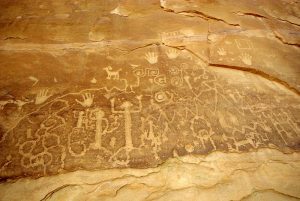
If you are exploring the rural areas of western Colorado you may see some examples of rock art created by prehistoric cultures. According to the Colorado Historical Society’s 1984 publication Northwest Colorado Prehistoric Context, “rock art sites are of two types: pictograph and petroglyphs. Rock art panels can range in size from a small single figure or motif to very large panels consisting of dozens of figures. Both pictographs and petroglyphs can be found on the same panel. Representations can range from realistic to highly stylized.” Pictographs are painted onto stone using natural pigments; usually they only survive in caves or other areas where they are protected from the elements. Petroglyphs, on the other hand, are scratched or carved into the stone.
One of the most famous collections of rock art in Colorado is the Shavano Valley near Montrose, which was inhabited as early as 1000 BC. The site features twenty-six panels of prehistoric rock art. Shavano Valley was inhabited by Ute Indians until about 1900 so it contains some more recent examples of rock art as well, along with many other archaeological finds from nearly three thousand years of habitation.
Another site with many examples of rock art is Dinosaur National Monument in northwestern Colorado. In 1964-65 a team from the University of Colorado conducted a major archaeological excavation on the site, which spanned the Colorado-Utah border. Their report, published by the University in 1970, is available to read online.
Rock art has also been found in the San Juans. In 1922, a team of archaeologists excavated there and reported their findings in “Further Archaeological Research in the Northeastern San Juan Basin of Colorado, During the Summer of 1922,” a two-part series in v.1, n.1 and v.1, n.2 of the Colorado Historical Society’s Colorado Magazine, now available online.
Conejos County in southwestern Colorado also has examples of petroglyphs. See the Colorado Historical Society’s An Archaeological Inventory in the Pike’s Stockade Area, Conejos County, Colorado (2007) for information on some of the rock art discovered in this region. See also the Colorado Historical Society’s Southwest Colorado Prehistoric Context publication.
A few isolated examples of rock art have also been found on the other side of the state, in southeastern Colorado. A 1930 archaeological survey of this part of the state “found only some thirteen sites with petroglyphs, as in most of the territory explored, fields, prairie, sand dunes, etc., there was no means for the Indians to produce pictographs on rocks.” An article on their findings can be found in the January 1931 issue of Colorado Magazine.
For general information on Native American rock art in Colorado, including the methods archaeologists use to classify the art by cultures and periods, see the Colorado Encyclopedia’s article “Rock Art of Colorado.” For a historical perspective on Colorado’s earliest peoples see the chapter “Ancient Inhabitants” in the Colorado Historical Society’s 1927 History of Colorado, which has been digitized by our library. Our collection also contains some helpful resources available for checkout in hard copy, including
- Archaeological Survey Along State Highway 139, Loma to Douglas Pass, published in 1986 by the Colorado Department of Highways, which contains an article about rock art.
- In the Shadow of the Rocks: Archaeology of the Chimney Rock District in Southern Colorado (University Press of Colorado, 1993).
- A Profile of the Cultural Resources of Colorado (Colorado Historical Society, 1996)
- Colorado Plateau Country Historic Context (Colorado Historical Society, 1984)
- Dinosaur National Monument Multiple Property Listing (Colorado Historical Society, 1986)
- The Western San Juan Mountains: Their Geology, Ecology, and Human History (University Press of Colorado, 1996)
- The Anasazi of Mesa Verde and the Four Corners (University Press of Colorado, 1996)
Want to see some rock art? Many archaeological sites are not publicized in order to protect the artifacts; however, there are some places you can go to see rock art including Mesa Verde; the Canyon Pintado Rock Art Historic District near Rangely; and Vogel Canyon Petroglyphs near La Junta. For information on these and other locations see History Colorado’s Public Archaeology list.
Finally, if you are an archaeologist, or if you are a landowner with rock art on your property, be sure and read Recording and Caring for Rock Art from the Colorado Office of Archaeology & Historic Preservation.
- How to Spot the Differences Between Eagles and Hawks - August 16, 2021
- How Transportation Projects Help Tell the Story of Colorado’s Past - August 9, 2021
- Time Machine Tuesday: The Night the Castlewood Canyon Dam Gave Way - August 3, 2021